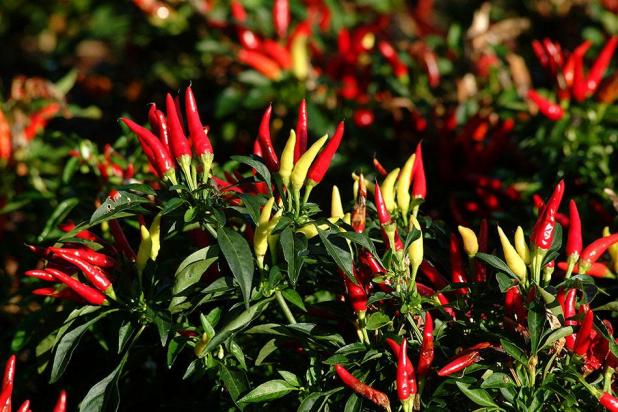
Ornamental pepper plants are the perfect way to both spruce up the late summer landscape and celebrate the transition into fall.
—LSU AgCenter file photo
Get It Growing: Ornamental peppers spice up fall
The South has no reason for fall foliage envy. The traditional colors of autumn can be found in ornamental peppers — which can be planted into any sunny landscape to add spice and fall flair.
The typical fall colors are inspired by the seasonal changing of leaves as temperatures cool and days become shorter. The South never seems to get the dramatic color changes that more northern climates enjoy. But look closely when you see ornamental pepper plants, and you will find the traditional colors of orange, yellow, red and purple.
Ornamental peppers (Capsicum annuum) are grown for their colorful, and sometimes edible, peppers. They can be grown both outdoors as a cool-season annual in Louisiana and in containers that can brought indoors to overwinter.
Peppers produce small white flowers in late spring through summer when flowers give rise to brightly colored fruits of many shapes and sizes. Some varieties of ornamental peppers can be found in variegated forms while others produce multiple fruit colors on the same plant.
The growth habit of most peppers is mounded and upright, and they come in a range of fruit and foliage colors. They are especially striking when planted en masse and serve as an excellent border plant. Plants can be used in containers and work well as a filler.
For the most color and fruit production, plant in full to partial sun. Plants typically grow to an average height of 14 to 18 inches with a width of 12 to 14 inches. Space plants 8 to 10 inches apart in the landscape in most any type of soil with a slightly acidic pH of 5.5 to 6.0 for the best plants.
Ornamental peppers can be planted in late spring with plants lasting until the first killing frost. Peppers tolerate the summer heat well. However, garden centers offer transplants in spring and again in late summer through early fall for planting.
When planting in the spring, fertilize after planting and then again at a half rate in early to midsummer. When planting in mid- or late summer, fertilize just once at planting. Once established, peppers are drought tolerant. However, irrigation may be necessary during extended dry weather.
You can find many varieties of ornamental peppers, including Chilly Chili (an All-America Selection in 2002), Medusa and Red Missile. Chilly Chili has non-pungent fruit and reaches about a foot tall with a spread of 8 to 10 inches. Fruit color of Chilly Chili ornamental peppers changes from yellow to orange and matures at red. It is a personal favorite for its petite, colorful fruit.
The Explosive series includes Ember, Ignite and Blast. Ember has dark purple foliage on a 12- to 14-inch-tall plant with purplish-red fruit. Ignite only reaches 6 to 8 inches tall with fruit that changes from ivory white to greenish-yellow to orange-red and grows well in containers and hanging baskets because of its small size. Blast reaches 8 to 10 inches tall and has yellow-green fruit that changes to scarlet red. The fruits of these three are edible with medium-hot flavor.
Calico has beautiful foliage with leaves that are speckled in shades of green, creamy white and purple. The fruits are glossy black oblong peppers that mature to red. This plant is primarily grown as an ornamental, but it is also valued for its edible qualities.
Another great purple variety is Purple Flash with dark purple foliage that is almost black. Fruit is small, round, glossy black, extremely hot and not recommended for eating.
Some of the other favorite recommendations from the LSU AgCenter Hammond Research Station are Black Hawk Hybrid, Hot Pops Purple and Midnight Fire and edible ornamental peppers Mad Hatter and Candy Cane Red.
